Motorola RMU2040 User Manual
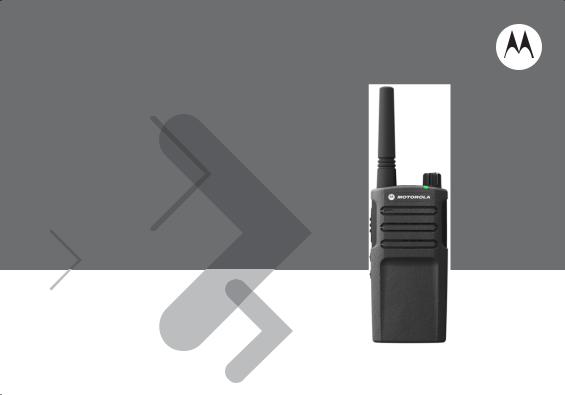
RM Series/Séries RM TwoWay Radios
Radios bidirectionnelles
User Guide
Guide de l’utilisateur
Models RMU2040, RMM2050 / Modèles RMU2043
MOTOROLA, MOTO, MOTOROLA SOLUTIONS and the Stylized M Logo are trademarks or registered trademarks of Motorola Trademark Holdings, LLC and are used under license. All other trademarks are the property of their respective owners. ©2013 Motorola, Inc. All rights reserved. Printed in Malaysia.
Motorola Solutions, Inc. 1301 East Algonquin Road Schaumburg, Illinois 60196, U.S.A. 800-367-2346 motorolasolutions.com

CONTENTS
Contents . . . . . . . . . . . . . . . . . . . . . . . . . . . .1
Safety . . . . . . . . . . . . . . . . . . . . . . . . . . . . . . .4
Introduction . . . . . . . . . . . . . . . . . . . . . . . . .5
Package Contents. . . . . . . . . . . . . . . . . . . . . .5
FCC Licensing Information . . . . . . . . . . . . .7
Canada Licensing Information . . . . . . . . . .7
General Information. . . . . . . . . . . . . . . . . . . . .7
The License Application . . . . . . . . . . . . . . . . .7
Batteries and Chargers
Safety Information . . . . . . . . . . . . . . . . . . . .8
Operational Safety Guidelines. . . . . . . . . . . . .9
Radio Overview . . . . . . . . . . . . . . . . . . . . .10
Parts of the Radio . . . . . . . . . . . . . . . . . . . . .10
On/Off/Volume Knob. . . . . . . . . . . . . . . .11
Accessory Connector . . . . . . . . . . . . . . .11
Model Label . . . . . . . . . . . . . . . . . . . . . .11
Microphone . . . . . . . . . . . . . . . . . . . . . . .11
Antenna |
11 |
|
|
|
|||
LED Indicator . . . . . . . . . . . . . . . . . . . . . |
11 |
|
|
Side Buttons . . . . . . . . . . . . . . . . . . . . . |
11 |
CONTENTS |
|
The Lithium-Ion (Li-Ion) Battery . . . . . . . |
11 |
||
Battery Features |
13 |
||
|
|||
About the Li-Ion Battery . . . . . . . . . . . . . |
13 |
|
|
Battery Recycling and Disposal . . . . . . . |
14 |
|
|
Installing the Lithium-Ion |
|
|
|
(Li-Ion) Battery . . . . . . . . . . . . . . . . . . . . |
15 |
|
|
Removing the Lithium-Ion |
|
|
|
. . . . . . . . . . . . . . . . . . . .(Li-Ion) Battery |
15 |
|
|
Power Supply, Adaptor and |
|
|
Drop-in Tray Charger. . . . . . . . . . . . . . . 17
Battery Life Information . . . . . . . . . . . . . 18
Charging the Battery . . . . . . . . . . . . . . . 20
1 English

CONTENTS
English
Getting Started . . . . . . . . . . . . . . . . . . . . . .27
Turning radio ON/OFF. . . . . . . . . . . . . . . . . .27 Adjusting Volume . . . . . . . . . . . . . . . . . . . . .27 Selecting a Channel . . . . . . . . . . . . . . . . . . .27 Talking and Monitoring . . . . . . . . . . . . . . . . .27 Receiving a Call . . . . . . . . . . . . . . . . . . . . . .28 Talk Range . . . . . . . . . . . . . . . . . . . . . . . . . .28 Radio LED Indicators . . . . . . . . . . . . . . . . . .30 Hands-Free Use/VOX . . . . . . . . . . . . . . . . . .31
With Compatible VOX Accessories. . . . .31 Setting VOX Sensitivity . . . . . . . . . . . . . .32 Microphone Gain. . . . . . . . . . . . . . . . . . .32 Battery Save . . . . . . . . . . . . . . . . . . . . . .32 Reset to Factory Defaults . . . . . . . . . . . .32 End of Transmission Tone
(Roger Beep Tone) . . . . . . . . . . . . . . . . .33
Programming Features . . . . . . . . . . . . . . .34
Programming Mode. . . . . . . . . . . . . . . . . . . .34
Learning to Read the Values the
Radio Signals You . . . . . . . . . . . . . . . . .34
Entering Programming Mode . . . . . . . . .37
Reading Frequencies Values . . . . . . . . .37
2
Reading CTCSS/DPL Values . . . . . . . . 38
Reading Auto-Scan Values . . . . . . . . . . 39
Programming Frequencies, Codes
and Auto-Scan . . . . . . . . . . . . . . . . . . . . 39
Programming Mode FAQ. . . . . . . . . . . . 40
Programming Values Example. . . . . . . . . . . 41
Example of Programming a Frequency . 41
Example of Programming a Code . . . . . 42
Example of Programming Auto-Scan . . 43
Other Programming Features . . . . . . . . . . . 44
Scan. . . . . . . . . . . . . . . . . . . . . . . . . . . . 44
Editing Scan List . . . . . . . . . . . . . . . . . . 45
Nuisance Channel Delete . . . . . . . . . . . 45
CPS (Computer Programming Software). . . 46
Bandwidth Select . . . . . . . . . . . . . . . . . . 47
Time-Out Timer . . . . . . . . . . . . . . . . . . . 47
Power Select . . . . . . . . . . . . . . . . . . . . . 47
Battery Type Setting . . . . . . . . . . . . . . . 47
Call Tones . . . . . . . . . . . . . . . . . . . . . . . 47
Scramble . . . . . . . . . . . . . . . . . . . . . . . . 48
Reverse Burst . . . . . . . . . . . . . . . . . . . . 48
Cloning Radios. . . . . . . . . . . . . . . . . . . . . . . 49

Cloning with a Multi Unit |
|
Antennas . . . . . . . . . . . . . . . . . . . . . . . . . . . |
71 |
|
Charger (MUC) . . . . . . . . . . . . . . . . . . . |
.49 |
Audio Accessories . . . . . . . . . . . . . . . . . . . . |
71 |
|
Cloning Radio using the Radio |
|
Battery . . . . . . . . . . . . . . . . . . . . . . . . . . . . . |
71 |
|
to Radio (R2R) Cloning Cable |
|
Carry Accessories . . . . . . . . . . . . . . . . . . . . |
72 |
|
(Optional Accessory). . . . . . . . . . . . . . . |
.51 |
Power Supplies AC Pin Adaptors. . . . . . . . . |
72 |
|
Cloning using the CPS (Computer |
|
Software Applications. . . . . . . . . . . . . . . . . . |
72 |
|
Programming Software) . . . . . . . . . . . . . |
53 |
Cables . . . . . . . . . . . . . . . . . . . . . . . . . . . . . |
72 |
|
Troubleshooting |
54 |
Chargers . . . . . . . . . . . . . . . . . . . . . . . . . . . |
72 |
|
Power Supplies |
73 |
|||
|
|
|||
Use and Care . . . . . . . . . . . . . . . . . . . . . . . |
58 |
|
|
|
Frequency and Code Charts . . . . . . . . . . . |
59 |
|
|
|
RMU2043 - UHF Default |
|
|
|
|
Frequencies Chart. . . . . . . . . . . . . . . . . . . . . |
59 |
|
|
|
RMU2040 - UHF Default |
|
|
|
|
Frequencies Chart. . . . . . . . . . . . . . . . . . . . . |
60 |
|
|
|
CTCSS and PL/DPL Codes . . . . . . . . . . . . . |
61 |
|
|
|
Programming Customized Frequencies |
66 |
|
|
CONTENTS
Motorola Limited Warranty for
the United States and Canada . . . . . . . . . .67 Accessories . . . . . . . . . . . . . . . . . . . . . . . .71
3 English
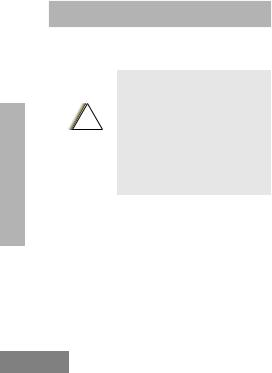
SAFETY
SAFETY
PRODUCT SAFETY AND RF EXPOSURE COMPLIANCE
!
C a u t i o n
Before using this product, read the operating instructions and RF energy awareness information contained in the Product Safety and RF Exposure booklet enclosed with your radio.
ATTENTION!
This radio is restricted to occupational use only to satisfy FCC RF energy exposure requirements.
This device complies with Part 15 of the FCC Rules. Operation is subject to the condition that this device does not cause harmful interference.
English 4

INTRODUCTION
Thank you for purchasing the Motorola® RM Series Radio. This radio is a product of Motorola's 80 plus years of experience as a world leader in the designing and manufacturing of communications equipment. The RM Series radios provide cost-effective communications for businesses such as retail stores, restaurants, schools, construction sites, manufacturing, property and hotel management and more. Motorola professional two-way radios are the perfect communications solution for all of today's fast-paced industries.
Note: Read this user guide carefully to ensure you know how to properly operate the radio before use
Business Radios,
Mailstop 1C15, Motorola
8000 West Sunrise Boulevard
Plantation, Florida 33322
PACKAGE CONTENTS
•Radio
•Holster
•Lithium-Ion Battery
•Power Supply
•Quick Reference Guide
•Warranty Card
•Drop-in Tray Charger
•Product Safety & RF Exposure Booklet
INTRODUCTION
5English

This User Guide can be downloaded from www.motorolasolutions.com/RMSeries. Product-related questions, contact:
1-800-448-6686 (US and Canada) 1-888-390-6456 on your TTY (Text Telephone)
INTRODUCTION
English 6

FCC LICENSING
INFORMATION
INTERFERENCE INFORMATION
This device complies with Part 15 of the FCC Rules. Operation is subject to the condition that this device does not cause harmful interference.
RM Series Business two-way radios operate on radio frequencies that are regulated by the Federal Communications Commission
(FCC). To transmit on these frequencies, you are required to have a license issued by the FCC. Application is made available on FCC Form 601 and Schedules D, H, and Remittance Form 159.
To obtain these FCC forms, request document 000601 which includes all forms and instructions. If you wish to have the document faxed, mailed or have questions, use the following contact information.
Faxed contact the |
Mailed call the FCC forms hotline at: |
Questions regarding FCC |
|
Fax-On- Demand |
|||
license contact the FCC at: |
|||
system at: |
|
||
|
|
||
|
|
|
|
1-202-418-0177 |
1-800-418-FORM |
1-888-CALL-FCC |
|
|
1-800-418-3676 |
1-888-225-5322 |
|
|
|
Or: http://www.fcc.gov |
|
|
|
|
LICENSING FCC INFORMATION
9English

FCC LICENSING INFORMATION
Before filling out your application, you must decide which frequency(ies) you can operate on. See “Frequencies and Code Charts”. For questions on determining the radio frequency, call Motorola Product Services at:
1-800-448-6686
Changes or modifications not expressly approved by Motorola may void the user’s authority granted by the FCC to operate this radio and should not be made. To comply with FCC requirements, transmitter adjustments should be made only by or under the supervision of a person certified as technically qualified to perform transmitter maintenance and repairs in the private land mobile and fixed services as certified by an organization representative of the user of those services.
Replacement of any transmitter component (crystal, semiconductor, etc.) not authorized by the FCC equipment authorization for this radio could violate FCC rules.
Use of this radio outside the country where it was intended to be distributed is subject to government regulations and may be prohibited
English 10

CANADA LICENSING
INFORMATION
GENERAL INFORMATION
The operation of your Motorola radio is subject to the Radiocommunications Act and must comply with rules and regulations of the Federal Government’s department of Industry Canada. Industry Canada requires that all operators using Private Land Mobile frequencies obtain a radio license before operating their equipment.
An application for your Industry Canada license is made on the form included with your radio. Additional forms and latest license application versions can be obtained from the nearest Industry Canada District office. A list of these offices is included for your information.
THE LICENSE APPLICATION
General Instructions
1.Fill in the items as per the instructions. If you need additional space for any item use the reverse side of the application.
2.Be sure to use a typewriter or print legibly.
3.Make a copy for your files.
4.Prepare a cheque or money order made out to the “Receiver General for Canada”, for an amount, which is on the following schedule, for each radio purchased. (License is valid until April 1st of each year, and the renewed.
5.Mail your completed application, along with your cheque or money order to the closest Industry Canada District office, according to the list on pages
To obtain the latest Canadian License Application form, please go to: www.ic.gc.ca
LICENSING CANADA
7English

BATTERIES AND CHARGERS SAFETY INFORMATION
BATTERIES AND
CHARGERS SAFETY
INFORMATION
This document contains important safety and operating instructions. Read these instructions carefully and save them for future reference.
Before using the battery charger, read all the instructions and cautionary markings on
•The charger,
•The battery, and
•The radio using the battery
1.To reduce risk of injury, charge only the rechargeable Motorola-authorized batteries. Other batteries may explode, causing personal injury and damage.
2.Use of accessories not recommended by Motorola may result in risk of fire, electric shock, or injury.
3.To reduce risk of damage to the electric plug and cord, pull by the plug rather than the cord when disconnecting the charger.
4.An extension cord should not be used unless absolutely necessary. Use of an improper extension cord could result in risk of fire and electric shock. If an extension cord must be used, make sure that the cord size is 18AWG for lengths up to 6.5 feet (2.0 m), and 16AWG for lengths up to 9.8 feet (3.0 m).
5.To reduce risk of fire, electric shock, or injury, do not operate the charger if it has been broken or damaged in any way. Take it to a qualified Motorola service representative.
6.Do not disassemble the charger; it is not repairable and replacement parts are not available. Disassembly of the charger may result in risk of electrical shock or fire.
7.To reduce risk of electric shock, unplug the charger from the AC outlet before attempting any maintenance or cleaning
English 8

OPERATIONAL SAFETY
GUIDELINES
•Turn the radio OFF when charging battery.
•The charger is not suitable for outdoor use. Use only in dry locations/conditions.
•Connect charger only to an appropriately fused and wired supply of the correct voltage (as specified on the product).
•Disconnect charger from line voltage by removing main plug.
•The outlet to which this equipment is connected should be nearby and easily accessible.
•In equipment using fuses, replacements must comply with the type and rating specified in the equipment instructions.
•Maximum ambient temperature around the power supply equipment must not exceed 40°C (104°F).
•Power output from the power supply unit must not exceed the ratings stated on the product label located at the bottom of the charger.
•Make sure that the cord is located where it will not be stepped on, tripped over, or subjected to water, damage, or stress.
CHARGERS AND BATTERIES INFORMATION SAFETY
9English
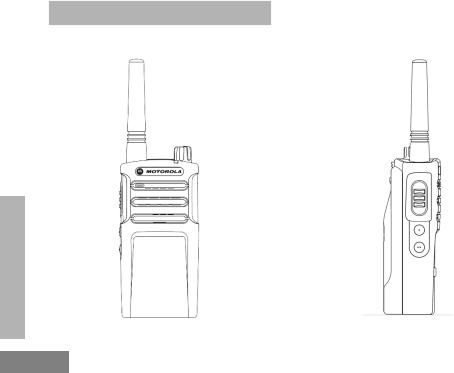
RADIO OVERVIEW
PARTS OF THE RADIO
Antenna
Microphone
RADIO OVERVIEW
On/Off/Volume knob
LED Indicator
Accessory |
|
PTT Button |
Connector |
|
SB1-Monitor |
|
|
|
|
|
Button |
|
|
SB2Scan/Nuisance |
Model Label |
Lithium-Ion |
Channel delete |
battery |
|
|
|
|
English 10

On/Off/Volume Knob
Used to turn the radio ON or OFF and to adjust the radio’s volume.
Accessory Connector
Used to connect compatible audio accessories.
Model Label
Indicates the model of the radio.
Microphone
Speak clearly into the microphone when sending a message.
Antenna On all RM Series radios, the antenna is non-removable
LED Indicator
Used to give battery status, power-up status, radio call information and scan status.
Side Buttons
Push-to-Talk (PTT) Button
•Press and hold down this button to talk, release to leasten it
Side Button 1 (SB1)
•The Side Button 1 is a general button that can be configured by the Computer
Programming Software - CPS. The default setting of SB1 is ‘Monitor’.
Side Button 2 (SB2)
•The Side Button 2 is a general button that can be configured by the CPS. The
SB2 default setting is set to scroll until the desired channel is selected.
RM Series provides a Li-Ion battery. For more information, see “Battery Feature on Pg.13.
OVERVIEW RADIO
11 English

RADIO OVERVIEW
This User Guide covers multiple RM Series models, and may detail some features your radio does not have. The radio’s model is shown on the bottom of the radio and provides you the following information:
|
Frequency |
Transmit |
Number of |
|
|
Model |
Power |
Antenna |
|||
Band |
Channels |
||||
|
(Watts) |
|
|||
|
|
|
|
||
|
|
|
|
|
|
RMU2043 |
UHF |
2 |
4 |
Non-Removable |
|
|
|
|
|
|
|
RMM2050 |
VHFMURS |
2 |
5 |
Non-Removable |
|
|
|
|
|
|
|
RMU2043 |
UHF |
2 |
4 |
Non-Removable |
|
|
|
|
|
|
English 12

BATTERY FEATURES
About the Li-Ion Battery
The RM Series radio comes equipped with a rechargeable Li-Ion battery. This battery should be charged before initial use to ensure optimum capacity and performance.
Battery life is determined by several factors. Among the more critical are the regular overcharge of batteries and the average depth of discharge with each cycle. Typically, the greater the overcharge and the deeper the average discharge, the fewer cycles a battery will last. For example, a battery which is overcharged and discharged 100% several times a day, lasts fewer cycles than a battery that receives less of an overcharge and is discharged to 50% per day. Further, a battery
which receives minimal overcharging and averages only 25% discharge, lasts even longer.
Motorola batteries are designed specifically to be used with a Motorola charger and vice versa. Charging in non-Motorola equipment may lead to battery damage and void the battery warranty. The battery should be at about 77°F (25°C) (room temperature), whenever possible. Charging a cold battery (below 50° F [10°C]) may result in leakage of electrolyte and ultimately in failure of the battery. Charging a hot battery (above 95°F [35°C]) results in reduced discharge capacity, affecting the performance of the radio. Motorola rapid-rate battery chargers contain a temperature-sensing circuit to ensure that batteries are charged within the temperature limits stated above.
OVERVIEW RADIO
13 English

RADIO OVERVIEW
Battery Recycling and Disposal
Li-Ion rechargeable batteries can be recycled. However, recycling facilities may not be available in all areas. Under various U.S. state laws and the laws of several other countries, batteries must be recycled and cannot be disposed of in landfills or incinerators. Contact your local waste management agency for specific requirements and information in your area. Motorola fully endorses and encourages the recycling of Li-Ion batteries. In the U.S. and Canada, Motorola participates in the nationwide Rechargeable Battery Recycling Corporation (RBRC) program for Li-Ion battery collection and recycling.
Many retailers and dealers participate in this program. For the location of the drop-off facility closest to you, access RBRC's Internet web site at:
www.rbrc.com or call:
1-800-8-BATTERY
This internet site and telephone number also provides other useful information concerning recycling options for consumers, businesses and governmental agencies.
English 14
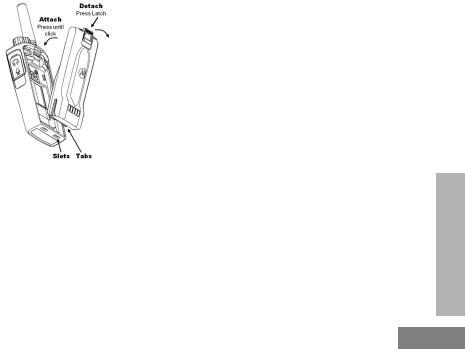
Installing the Lithium-Ion (Li-Ion) Battery |
Removing the Lithium-Ion (Li-Ion) Battery |
1. Turn OFF the radio.
2. Push down the battery latch and hold it depressed while removing the battery.
3. Pull the battery away from the radio.
1.Turn OFF the radio.
2.With the Motorola logo side up on the battery pack, fit the tabs at the bottom of the battery into the slots at the bottom of the radio’s body.
3.Press the top part of the battery towards the radio until a click is heard.
Note: To learn about the Li-Ion Battery Life features, refer to “About the Li-Ion Battery” on page 13
OVERVIEW RADIO
15 English
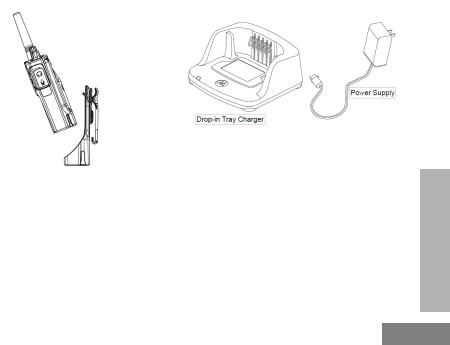
Holster
1.Slide the radio into the base of the holster and then press the radio against the back of the holster until the top clips are inserted in the top latches of the battery.
2.To remove, detach the top clips of the holster from the top latches of the battery and then slide the radio up from the holster pocket.
Power Supply and Drop-in Tray Charger
The radio is equipped with one Drop-in Tray Charger and one Power Supply with Adaptor. For details, see “Chargers” on page 72.
OVERVIEW RADIO
17 English

Battery Life Information
When the Battery Save feature is ON (enabled by default) the battery life will be longer. The following chart summarizes battery life estimations:
RADIO OVERVIEW
Note: Battery life is estimated based on 5% transmit/ 5% receive/ 90% standby standard duty cycle
English 18
